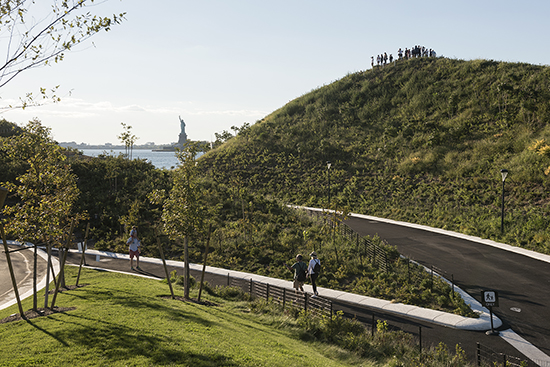|
Subscribe / Renew |
|
|
Contact Us |
|
| ► Subscribe to our Free Weekly Newsletter | |
| home | Welcome, sign in or click here to subscribe. | login |
Construction
| |
 |
January 22, 2018
National finalist: Gold award
Special Projects
Hart Crowser

Project: Governors Island Park and Public Space
Client: West 8 Urban Design & Landscape Architecture
Before its transformation, New York City's Governors Island was a flat parcel of land that had been used in a number of ways over the years.
The former Revolutionary War fort and Civil War arsenal was expanded 100 years ago using fill that was barged and dumped from a subway excavation. It was later converted to a Coast Guard base with more than 3,500 residents. Following its decommissioning in the mid-1990s, the site was languishing.
West 8 Urban Design & Landscape Architecture won a design competition to transform the island in 2007. The 170-acre parcel, a seven-minute ferry ride from Lower Manhattan, was transformed into a destination park enjoyed by more than a million visitors a year.
Hart Crowser performed the geotechnical engineering. Magnusson Klemencic Associates was the civil engineer, Matthews Nielsen Landscape Architecture was the landscape architect, and Turner Construction was the general contractor.
The site now has rolling meadows, playfields, recreational areas, and — its signature feature — four large hills rising as high as 80 feet above the surface of the harbor, allowing 360-degree views of the city.
Creating these dramatic hills on a formerly flat site was a challenge that Hart Crowser embraced. The best spot for the hills was right next to the island seawall and on top of 100 feet of soil from the Lexington Avenue subway excavation. The soft soil wouldn't support the steep hill: The man-made hill on the fill wanted to slide into the harbor.
To determine the likelihood of this happening, Hart Crowser performed exhaustive testing and analyses of the site. This included examining existing soil, creating 3-D models to test for potential failure, measuring soil drainage and looking for evidence of weakness in the deep glacial clays offshore. With every analysis, it became clearer that understanding the soft soil behavior was the key to creating this signature New York City park.
Hart Crowser devised ways to make the slopes steep and allow the landscape architects to sculpt the sides and create an environment for dense, slope-anchoring vegetative growth. By reinforcing the steepest slopes with man-made, elongated sheets of high-density polyethylene called geogrids, Hart Crowser was able to add strength to the soil along the slopes and allowed them to be built as steep as a 45-degree angle.
Engineers made the heaviest sections lighter by using a lightweight volcanic rock as fill that weighs only about half of typical soil fill and possesses just as much strength. Hart Crowser's model determined where the lightweight fill was required, how deep or thick it needed to be, and how far back into the hills it needed to extend to reduce the unstable forces on the soft subsoils and increase the safety factors against slope failure.
Hart Crowser also incorporated all the construction debris from the site — nine major buildings' worth — into the project. Fifty-thousand cubic yards of construction debris was processed on-island to a maximum size of 8 inches so it would drain rapidly, and placed in lifts in the middle of the hills.
Hart Crowser designed the project to stand up to major windstorms, rainstorms and even hurricanes. Its resilient design was tested recently by Hurricane Sandy and passed with flying colors. Despite being hit by a 14-foot wall of water and buffeted by 80 mph winds, the island's 3,000 new trees and newly planted salt water-resistant grasses and shrubs stood strong.
Other Stories:
- National finalist: Platinum Award
Structural Systems
Magnusson Klemencic Associates - National finalist: Gold award
Structural Systems
COWI North America - National finalist: Gold award
Special Projects
Parsons - Best in State: Gold Award
Successful Fulfillment of Client/Owner Needs
GeoEngineers - Best in State: Gold Award
Unique or Innovative Applications
Golder Associates - Best in State: Gold Award
Social, Economic and Sustainable Design
J-U-B Engineers - Best in State: Gold Award
Future Value to Engineering Profession
MIG/SvR - Best in State: Gold Award
Complexity
Stantec - Engineer of the Year


